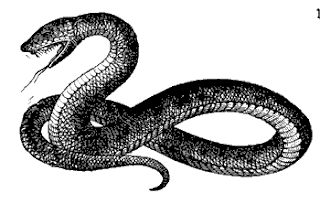
The Australian explorer
May 25. … At two we arrived at the base of a hill of considerable magnitude, terminating westward in an abrupt perpendicular rock from two hundred and fifty to three hundred feet high. The country we passed over was of the most miserable description; the last eight miles without a blade of grass….. This hill was named
Peter Lund Simmonds in The Curiosities of Food (1859) has a whole series of snake-eating anecdotes, all from the perspective of a civilised eater observing the ignorant (even if noble) savage or the fearless frontier pioneer. In case you are lost in the wilderness and get hungry and are not afraid to catch a snake (which in Australia is highly likely to be extremely poisonous) and do not already know how to cook one, Simmonds most helpfully quotes a certain Dr Lang’s account of snake cooking in Australia:
“One of the black fellows took the snake, and placing it on the branch of a tree, and striking it on the back of the head repeatedly with a piece of wood, threw it into the fire. The animal was not quite dead, for it wriggled for a minute or two in the fire, and then became very stiff and swollen, apparently from the expansion of gas in its body. The black fellow then drew it out of the fire, and with a knife cut through the skin longitudinally on both sides of the animal, from the head to the tail. He then coiled it up as a sailor does a rope, and laid it again upon the fire, turning it over again and again with a stick till he thought it sufficiently done on all sides, and superintending the process of cooking it with all the interest imaginable. When he thought it sufficiently roasted, he thrust a stick into the coil, and laid it on the grass to cool, and when cool enough to admit of handling, he took it up again, wrung off its head and tail, which he threw away, and then broke the rest of the animal by the joints of the vertebrae into several pieces, one of which he threw to the other black felllow, and another he began eating himself with much apparent relish.”
The observer in snake-eating anecdotes is almost always repelled by the idea, and responds with disgust or admiration at the habits or bravery of the eater. What is it about snake? Newly-hatched birds and other baby animals are said to react in fear to lengths of rope, suggesting that we are biologically programmed to see them as dangerous enemies. Snakes are stealthy creatures too, and we are more inclined to fear that which can sneak up on us. The poor eel is tarred with the same brush. Eels are fish, pure and simple, but they have a snake-like shape and this is often given as the reason for avoiding them. It seems unfair to me.
Here is Charles Elmé Francatelli’s Eel Pie from his 1860’s book The Cook's Guide and Housekeeper's and Butler's Assistant.
Skin, draw, and cleanse two good-sized Thames eels; trim off the fins, and cut them up in pieces about three inches long, and put these in a stewpan with two ounces of butter, some chopped mushrooms, parsley, and a very little shalot, nutmeg, pepper and salt, two glasses of sherry, one of Harvey sauce, and barely enough water to cover the surface of the eels; set them on the fire, tnd as soon as they come to a boil, let them be removed, and the pieces of eels placed carefully in a pie dish; add two ounces of butter, kneaded with two ounces of flour, to the sauce; and having stirred it on the fire to thicken, add the juice of a lemon, and pour it over the pieces of eels in the pie dish; place some hard yolks of eggs on the top; cover with puff-paste; ornament the top; egg it over, bake for about an hour, and serve, either hot or cold.
This Day, Last Year ...
We thought about lettuce.
2 comments:
I don't eat eel, not because of the snake-like shape - heck, I've eaten rattlesnake, which is quite good and does not taste like chicken - but eel's too greasy for my palate.
You could to a lot worse to eat a snake. Plenty of protein, no fine bones. Yum!
Nene
Nene you are very brave. I was hoping that someone who had actually eaten snake would respond. What does rattlesnake taste like? I know - rattlesnake, yes?
Post a Comment